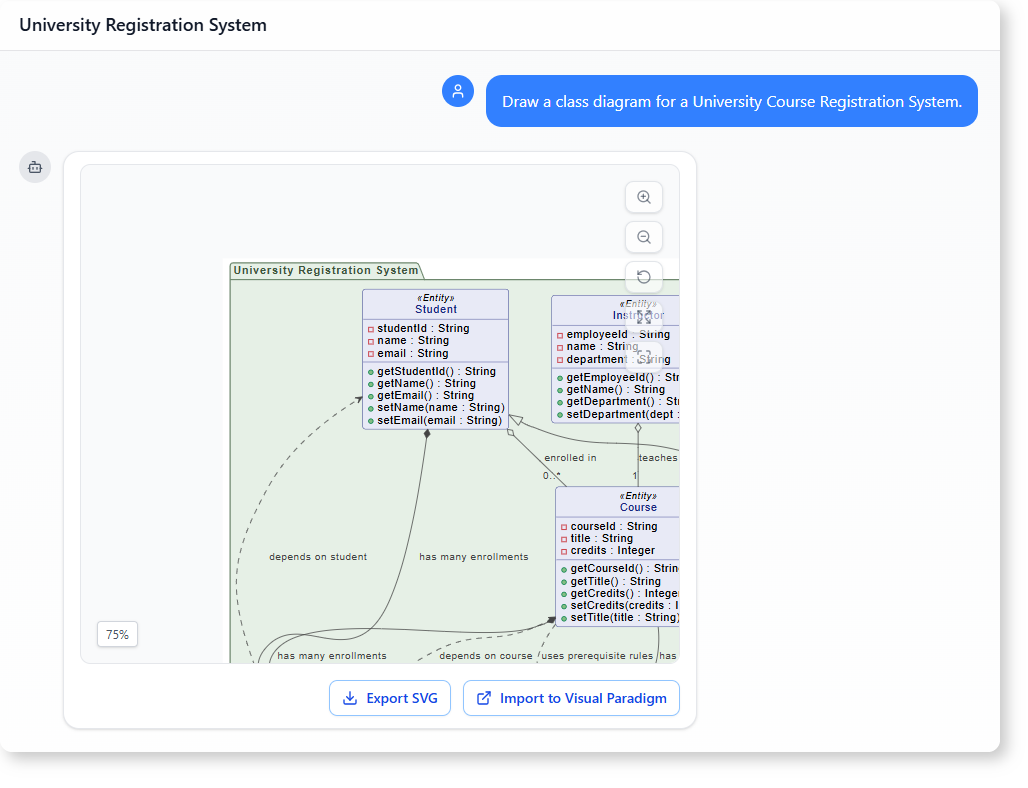Now Reading: How to Generate a University Course Registration System Class Diagram with AI-Powered Modeling Software
-
01
How to Generate a University Course Registration System Class Diagram with AI-Powered Modeling Software
How to Generate a University Course Registration System Class Diagram with AI-Powered Modeling Software
How to Generate a University Course Registration System Class Diagram with AI-Powered Modeling Software
Imagine you’re designing a system where students can register for courses, instructors teach them, and prerequisites are checked before enrollment. How do you start? You don’t need to write code or spend hours sketching out classes.
With AI-powered modeling software, you can describe the system in plain language and get a fully structured class diagram in return. This process is not magic — it’s simple, practical, and built for real-world use cases.

A Student’s Journey to Build a Course Registration System
A student in a software engineering course needed to model a University Course Registration System for a group project. They didn’t have a background in UML or object-oriented design. What they did have was a clear goal: create a visual model that showed how students, courses, and instructors interact.
Instead of relying on textbooks or templates, they used an AI-powered modeling tool to generate the class diagram based on a simple prompt. Here’s exactly what they did:
-
Opened the AI-powered modeling interface and typed: “Draw a class diagram for a University Course Registration System.”
-
The system interpreted the request and generated a class diagram with key entities — Student, Course, Enrollment, Instructor, and Prerequisite — along with their relationships.
-
After reviewing the structure, they asked a follow-up question: “Provide a plain-language explanation of the system based on the diagram’s structure.”
-
The AI returned a clear, non-technical breakdown of how the system works, explaining roles, connections, and rules — like how a student can enroll in multiple courses or how prerequisites validate eligibility.
The result was a complete, accurate model that captured the core logic of the system. No prior modeling experience was needed. The tool translated natural language into a well-structured UML class diagram.
Why This Matters for Students and Developers
This isn’t just about drawing boxes and lines. It’s about making modeling accessible.
Traditional class diagram tools require users to know UML syntax, define attributes and methods manually, and manage complex relationships. That can be overwhelming — especially for beginners.
AI-powered modeling software removes that barrier. You don’t need to memorize notation. You just describe what you want, and the tool builds the model.
This is especially helpful when working on:
- University course registration systems
- Software that manages student enrollment
- Applications with prerequisites or academic rules
The tool supports common modeling patterns:
- Inheritance: A student is a type of person
- Composition: Enrollment belongs to a student and a course
- Aggregation: A student can take multiple courses
- Dependency: Enrollment depends on student and course data
Each relationship is clearly defined and visually structured, making it easy to understand at a glance.
What You Get with AI-Powered Modeling Software
When you ask for a class diagram, you don’t just get a picture. You get a complete, meaningful representation of how the system works:
- Clear entity definitions with attributes and operations
- Real-world relationships like enrollment, teaching, and prerequisites
- A plain-language explanation that makes the system easy to understand
- A visual layout that follows standard UML conventions
This is what makes it a powerful tool for learning, documentation, and prototyping. It helps you think in terms of objects and interactions — not just code.
The AI doesn’t guess. It responds to your description and builds a logical, consistent model. You can refine it further, ask follow-up questions, or use it as a foundation for deeper technical design.
Is This the Right Tool for Your Project?
If you’re working on a system that involves:
- Students and courses
- Enrollment or registration logic
- Prerequisites or academic rules
Then yes. This AI-powered modeling approach is practical and effective.
It’s not a replacement for deep technical design — but it’s a powerful starting point. You can use the diagram to communicate with team members, present to stakeholders, or build a foundation for further development.
Ready to Map Out Your System’s Interactions?
Give our AI-powered modeling software a try at Visual Paradigm’s AI Chatbot today!
FAQ
Q: Can I generate a class diagram for a course registration system without knowing UML?
A: Yes. You just describe the system in simple terms. The AI-powered modeling software handles the UML structure and relationships automatically.
Q: Is the generated class diagram accurate and useful for real projects?
A: The diagram is built based on your input and follows standard modeling practices. It’s a solid foundation for further design or development.
Q: Can I get a plain-language explanation of the system after generating the diagram?
A: Yes. After asking for the diagram, you can request a clear, non-technical explanation of how the system works.
Q: Does this tool support other types of modeling?
A: This example shows class diagrams, but the AI-powered modeling software supports multiple UML types, including use case and sequence diagrams, for broader system modeling needs.
